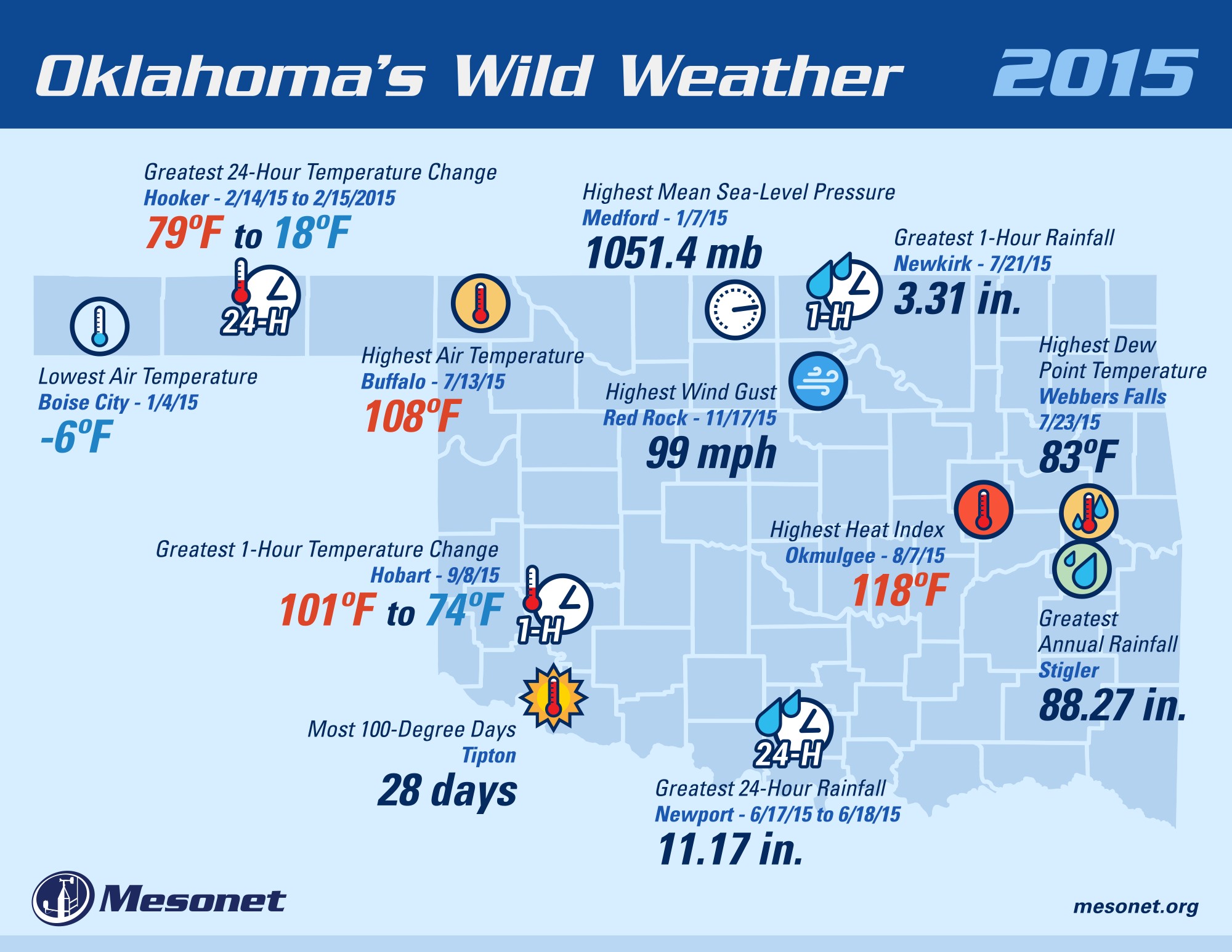
Agricultural News
Wet December Assures 2015 is Wettest Year Ever for Oklahoma
Sun, 03 Jan 2016 17:50:04 CST
 Oklahoma weather is always about the extremes- and 2015 did not disappoint- as can be seen in the 2015 weather graphic above.
Oklahoma weather is always about the extremes- and 2015 did not disappoint- as can be seen in the 2015 weather graphic above.
According to Gary McManus, Oklahoma State Climatologist, Mother Nature managed to save some of the worst of 2015's weather for last, ending the year with a powerful winter storm that, while significant for western Oklahoma, was historic for the eastern half of the state. The December 26-28 event prompted blizzard, ice storm and winter storm warnings for western Oklahoma while the eastern half was awash in flood-related emergencies.
McManus writes in his latest Mesonet Ticker (from January 2nd) that "Flooding was the main concern across eastern Oklahoma where 6-12 inches fell over the three day period."
"Numerous roads were closed due to flooding, and floodwaters from dams in northeast Oklahoma led to evacuation warnings. Widespread catastrophic damage was reported along the Illinois River basin as the river reached record flood levels. The river crested at 30.69 feet near Tahlequah on Dec. 28, besting the previous record from that location of 27.94 feet on May 10, 1950.
"The storm was not without other modes of hazardous weather. Numerous tornado warnings were issued in central and eastern Oklahoma on the 26th, and several instances of large hail were also reported. Preliminary reports indicate possible twister touchdowns just to the southeast of the Oklahoma City metro area, yet to be confirmed by the National Weather Service (NWS). There were two confirmed tornadoes earlier in the month on Dec. 12 in southeastern Oklahoma. One of those tornadoes, an EF2 that touched down near Valliant in McCurtain County, injured three. A total of 109 tornadoes were reported in Oklahoma during 2015 according to preliminary NWS statistics. That?s the third highest annual total since accurate records began in 1950. Two deaths and 55 injured were attributed to tornadoes during 2015.
"December ended as the wettest on record for the state according to preliminary statistics from the Oklahoma Mesonet. The statewide average precipitation for the month was 5.92 inches, 3.86 inches above normal.
"The previous record of 4.87 inches was set back in 1984. Those records date back to 1895. The southeastern and east central climate divisions had astounding averages of 13.01 inches and 12.39 inches, respectively, both more than 9 inches above normal and obviously the wettest on record for those regions. Mt. Herman led the Mesonet with 16.68 inches for the month, and 30 of the Mesonet?s 120 stations recorded at least 10 inches of rainfall. The highest total ever recorded during December was 18.13 inches from the NWS cooperative observing site at Bear Mountain Tower back in 1971. Mt. Herman?s total ranks as the fifth highest December total on record for the state. The far western Panhandle stations of Kenton and Boise City were the only locations to record less than an inch of precipitation with the former having the lowest total at 0.58 inches. Boise City reported 8 inches of snow for the month to bring their seasonal total to 16 inches, the highest in the state.
"The second wettest November and wettest December on record gave 2015 a final push past the previous wettest calendar year by half a foot with a preliminary statewide average of 53.88 inches.
"The record prior to 2015 was held by 1957 at 47.88 inches. The new record obviously came with some equally monumental localized totals. The NWS cooperative observing station at Daisy in Atoka County blasted past the previous record for wettest calendar year at any location in the state with 89.69 inches, topping Tuskahoma's 88.27 inches in 1990. The Mesonet site at Stigler tied that previous record as well. In all, 12 Mesonet stations and five NWS cooperative sites topped 80 inches for the year according to preliminary data. Not surprisingly, Kenton brought up the rear with a total of 21.45 inches, but that is still more than 6 inches above normal. May captured the record for wettest month in Oklahoma history with a statewide average of 14.44 inches, topping October 1941?s 10.75 inches.
"December ended much warmer than normal despite the late-month cool down. According to preliminary data from the Oklahoma Mesonet, the statewide average temperature was 44.5 degrees, 5.6 degrees above normal to rank as the fourth warmest on record.
"Arnett and Waurika led the state with readings of 80 degrees on December 11, although high temperatures of at least 60 degrees occurred in the state on 23 of the month's 31 days. Highs reached at least 70 degrees on 14 days. Several sites across eastern Oklahoma had a low temperature of 66 degrees on the 12th, which is about 15 degrees above the normal high temperature for that date. Idabel led the state with a monthly average temperature of 50.9 degrees, while Kenton had the lowest at 34.2 degrees. The year finished quite warm with a statewide average of 61 degrees, 1.1 degrees above normal. That ranks the year as the 17th warmest on record. The Buffalo and Freedom Mesonet sites reached 108 degrees to earn the year's highest readings. The lowest temperature of minus 6 degrees was recorded at Boise City back on January 4. The Okmulgee Mesonet site recorded a heat index of 118 degrees to earn top prize in that category.
"Oklahoma started 2015 with 59 percent of the state in drought according to the U.S. Drought Monitor, and peaked in early April at 68 percent.
"At that point, nearly 40 percent of Oklahoma was considered in at least extreme drought. The Drought Monitor's intensity scale slides from moderate-severe- extreme-exceptional, with exceptional being the worst classification. Drought was completely eradicated by early June, but a dry second half of the summer brought flash drought back into Oklahoma by early August, peaking once again in mid-October with 36 percent of the state back in drought. The dry conditions were once again eradicated by the heavy rains of November and December.
2016 Predictions
"The National Weather Service's Climate Prediction Center (CPC) expects the El Nino that is thought to have impacted both our spring and late fall-early winter weather to remain strong through winter before dissipating during the spring or early summer of 2016.
"With that as the backdrop, CPC outlooks call for increased odds of above normal precipitation across southwestern Oklahoma and the Panhandle during January.
"In the longer term, they see increased odds for above normal precipitation across most of Oklahoma through mid-spring, with greater chances across the western half of the state. There are no clear indications in the outlooks for temperature."
WebReadyTM Powered by WireReady® NSI
Top Agricultural News
More Headlines...





